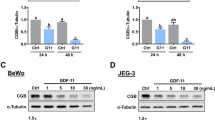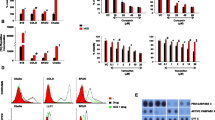Abstract
For many breast cancer patients, human chorionic gonadotropin beta (hCGβ), which is a subunit of a hormone produced by the trophoblast and is essential for maintaining pregnancy, is expressed in the breast cancer cells. However, the mechanism as to how the CGβ in cell affects the cancer development is not very clear. Mouse breast carcinoma 4T1 with stably hCGβ expression (4T1-hCGβ) was established and transplanted into the Balb/c mouse abdominal mammary gland. hCGβ suppressed breast cancer cell viability in vitro, and dramatically inhibited tumor growth and attenuated tumor vessel formation in vivo. An 86–88% reduction in tumor volume in animals injected with breast cancer expressing hCGβ, as opposed to those injected with breast cancer without hCGβ expression, was observed. The production of p21 was promoted by hCGβ, whereas the Cdk2 was decreasing. These indicate that p21 signal pathway is involved in this process. Significant apoptosis was also detected in hCGβ-expressing breast cancer cells as well as the enhancement of Bax protein expression. Moreover, hCGβ blocked the blood vessels formation by inhibiting the expression of MMP9 and VEGF. Further hormone secretion analyses show that the anti-tumor activity induced by hCGβ is not related to the endocrine function.







Similar content being viewed by others
Abbreviations
- hCGβ:
-
human chorionic gonadotropin beta
- GFP:
-
green fluorescent protein
References
Parkin DM (2001) Global cancer statistics in the year 2000. Lancet Oncol 2(9):533–543
Gao RJ, Bao HZ, Yang Q, Cong Q, Song JN, Wang L (2005) The presence of serum anti-p53 antibodies from patients with invasive ductal carcinoma of breast: correlation to other clinical and biological parameters. Breast Cancer Res Treat 93(2):111–115
Taback B, Chan AD, Kuo CT, Bostick PJ, Wang HJ, Giuliano AE, Hoon S (2001) Detection of occult metastatic breast cancer cells in blood by a multimolecular marker assay: correlation with clinical stage of disease. Cancer Res 61(24):8845–8850
Span PN, Manders P, Heuvel JJ, Thomas CM, Bosch RR,Beex LV, Sweep CG (2003) Molecular beacon reverse transcription-PCR of human chorionic gonadotropin-beta-3, -5, and \-8 mRNAs has prognostic value in breast cancer. Clin Chem 49(7):1074–1080
Srivastava P, Russo J, Russo IH (1997) Chorionic gonadotropin inhibits rat mammary carcinogenesis through activation of programmed cell death. Carcinogenesis 18(9):1799–1808
Rao ChV, Li X, Manna SK, Lei ZM, Aggarwal BB (2004) Human chorionic gonadotropin decreases proliferation and invasion of breast cancer MCF-7 cells by inhibiting NF-kappaB and AP-1 activation. J Biol Chem 279(24):22510–25503
Pulaski BA, Ostrand-Rosenberg S (1998) Reduction of established spontaneous mammary carcinoma metastases following immunotherapy with major histocompatibility complex class II and B7.1 cell-based tumor vaccines. Cancer Res 58(7):1486–1493
Banka CL, Lund CV, Nguyen MT, Pakchoian AJ, Mueller BM, Eliceiri BP (2006) Estrogen induces lung metastasis through a host compartment-specific response. Cancer Res 66(7):3667–3672
Medina D (2004) Breast cancer: the protective effect of pregnancy. Clin Cancer Res 10(1 pt 2):380–384 (Suppl)
Grubbs CJ, Juliana MM, Whitaker LM (1988) Short-term hormone treatment as a chemopreventive method against mammary cancer initiation in rats. Anticancer Res 8(1):113–117
Guzman RC, Yang J, Rajkumar L, Thordarson G, Chen X, Nandi S (1999) Hormonal prevention of breast cancer: mimicking the protective effect of pregnancy. Proc Natl Acad Sci USA 962:2520–2525
Russo IH, Koszalka M, Russo J (1991) Comparative study of the influence of pregnancy and hormonal treatment on mammary carcinogenesis. Br J Cancer 64(3):481–484
Medina D, Kittrell FS (2003) p53 function is required for hormone-mediated protection of mouse mammary tumorigenesis. Cancer Res 63(19):6140–6143
Sivaraman L, Conneely OM, Medina D, O’Malley BW (2001) p53 is a potential mediator of pregnancy and hormone-induced resistance to mammary carcinogenesis. Proc Natl Acad Sci USA 98(22):12379–12384
Pati D, Haddad BR, Haegele A, Thompson H, Kittrell FS, Shepard A, Montagna C, Zhang N, Ge G, Otta SK, McCarthy M, Ullrich RL, Medina D (2004) Hormone-induced chromosomal instability in p53-null mammary epithelium. Cancer Res 64(16):5608–5616
Levine AJ (1997) p53, the cellular gatekeeper for growth and division. Cell 88(3):323–331
Sherr CJ, Roberts JM (1999) CDK inhibitors: positive and negative regulators ofG1-phase progression. Genes Dev 13(2):1501–1512
Modestou M, Puig-Antich V, Korgaonkar C, Eapen A, Quelle DE (2001) The alternative reading frame tumor suppressor inhibits growth through p21-dependent and p21-independent pathways. Cancer Res 61(7):3145–3150
Eischen CM, Roussel MF, Korsmeyer SJ, Cleveland JL (2001) Bax loss impairs Myc-induced apoptosis and circumvents the selection of p53 mutations duringmyc-mediated lymphomagenesis. Mol Cell Biol 21(22):7653–7662
Choudhuri T, Pal S, Agwarwal ML, Das T, Sa G (2002) Curcumin induces apoptosis in human breast cancer cells through p53-dependent Bax induction. FEBS Lett 512(1–3):334–340
Zhang L, Yang N, Carcia JR, Mohamed A, Benencia F, Rubin SC, Allman D, Coukos G (2002) Generation of a syngeneic mouse model to study the effects of vascular endothelial growth factor in ovarian carcinoma. Am J Pathol 161(16):2295–2309
Danna EA, Sinha P, Gilbert M, Clements VK, Pulaski BA, Ostrand-Rosenberg S (2004) Surgical removal of primary tumor reverses tumor-induced immunosuppression despite the presence of metastatic disease. Cancer Res 64(6):2205–2211
Siler-Khodr TM, Yu FQ, Wei P, Tao SX, Liu YQ (2004) Contraceptive action of a gonadotropin-releasing hormone II analog in the rhesus monkey. J Clin Endocrinol Metab 89(9):4513–4520
Guo S, Russo IH, Lareef MH, Russo J (2004) Effect of human chorionic gonadotropin in the gene expression profile of MCF-7 cells. Int J Oncol 24(2):399–407
Mo FE, Muntean AG, Chen CC, Stolz DB, Watkins SC, Lau LF (2002) CYR61 (CCN1) is essential for placental development and vascular integrity. Mol Cell Biol 22(24):8709–8720
Stoeltzing O, Ahmad SA, Liu W, McCarty MF, Wey JS, Parikh AA, Fan F, Reinmuth N, Kawaguchi M, Bucana CD, Ellis LM (2003) Angiopoietin-1 inhibits vascular permeability, angiogenesis, and growth of hepatic colon cancer tumors. Cancer Res 63(12):3370–3377
Williams TM, Medina F, Badano I, Hazan RB, Hutchinson J, Muller WJ, Chopra NG, Scherer PE, Pestell RG, Lisanti MP (2004) Caveolin-1 gene disruption promotes mammary tumorigenesis and dramatically enhances lung metastasis in vivo. Role of Cav-1 in cell invasiveness and matrix metalloproteinase (MMP-2/9) secretion. J Biol Chem 279(49):51630–51646
Gasco M, Shami S, Crook T (2002) The p53 pathway in breast cancer. Cancer Res 4(2):70–76
Jerry DJ, Kittrell FS, Kuperwasser C, Laucirica R, Dickinson ES, Bonilla PJ, Butel JS, Medina D (2000) A mammary-specific model demonstrates the role of the p53 tumor suppressor gene in tumor development. Oncogene 19(8):1052–1058
Ling XY, Arlinghaus RB (2005) Knockdown of STAT3 expression by RNA interference inhibits the induction of breast tumors in immunocompetent mice. Cancer Res 65(7):2532–2536
Stewart ZA, Leach SD, Pietenpol JA (1999) p21(Waf1/Cip1) inhibition of cyclin E/Cdk2 activity prevents endoreduplication after mitotic spindle disruption. Mol Cell Biol 19(1):205–215
Pal S, Datta K, Mukhopadhyay D (2001) Central role of p53 on regulation of vascular permeability vascular endothelial growth factor (VPF/VEGF) in mammary carcinoma. Cancer Res 61(18):6952–6957
Acknowledgement
This work was supported by the grants from “863” Project of China Ministry of Science and Technology (2004AA215182) and Key Innovation Research Programs of the Chinese Academy of Sciences (KSCX2-SW-201).
Author information
Authors and Affiliations
Corresponding author
Rights and permissions
About this article
Cite this article
Shi, SQ., Xu, L., Zhao, G. et al. Apoptosis and tumor inhibition induced by human chorionic gonadotropin beta in mouse breast carcinoma. J Mol Med 84, 933–941 (2006). https://doi.org/10.1007/s00109-006-0085-x
Received:
Accepted:
Published:
Issue Date:
DOI: https://doi.org/10.1007/s00109-006-0085-x




